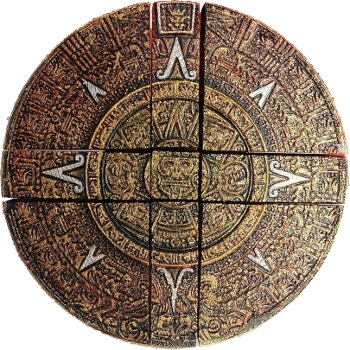
Above:Front view
Click a thumbnail to see its larger version and description.
A cylindrical Floppy Cube resembling a famous Mexica sculpture.
The Sun Stone, Stone of the Five Eras, or sometimes called Aztec calendar stone is a late post-classic Mexica sculpture housed in the National Anthropology Museum in Mexico City, and is perhaps the most famous work of Aztec sculpture.
The original stone is 358 centimetres (11.75 ft) in diameter and 98 centimetres (3.22 ft) thick, and it weighs about 24 tons.
Shortly after the Spanish conquest, the monolithic sculpture was buried in the Zócalo, the main square of Mexico City. It was rediscovered on December 17, 1790 during repairs on the Mexico City Cathedral.
Following its rediscovery, the calendar stone was mounted on an exterior wall of the Cathedral, where it remained until 1885.
The sculpted motifs that cover the surface of the stone refer to central components of the Mexica cosmogony.
In the center of the monolith is the face of the solar deity, Tonatiuh, which appears inside the glyph for "movement" (Nahuatl: ?llin), the name of the current era. The central figure is shown holding a human heart in each of his clawed hands, and his tongue is represented by a stone sacrificial knife (Tecpatl).
The four squares that surround the central deity represent the four previous suns or eras, which preceded the present era, 4 Movement (Nahuatl: Nahui ?llin). The Aztecs changed the order of the suns and introduced a fifth sun named 4 Movement after they seized power over the central highlands.[8] Each era ended with the destruction of the world and humanity, which were then recreated in the next era.
The top right square represents 4 Jaguar' (Nahuatl: Nahui ?c?lotl'), the day on which the first era ended, after having lasted 676 years, due to the appearance of monsters that devoured all of humanity.
The top left square shows 4 Wind' (Nahuatl: Nahui Eh?catl'), the date on which, after 364 years, hurricane winds destroyed the earth, and humans were turned into monkeys.
The bottom left square shows 4 Rain' (Nahuatl: Nahui Quiyahuitl'). This era lasted 312 years, before being destroyed by a rain of fire, which transformed humanity into turkeys.
The bottom right square represents 4 Water' (Nahuatl: Nahui Atl'), an era that lasted 676 years and ended when the world was flooded and all the humans were turned into fish.
Placed among these four squares are three additional dates, 1 Flint (Tecpatl), 1 Rain (Atl), and 7 Monkey (Ozomahtli), and a Xiuhuitzolli, or ruler's turquoise diadem, glyph. It has been suggested that these dates may have had both historical and cosmic significance, and that the diadem may form part of the name of the Mexica ruler Moctezuma II.
The inventor printed the pieces and painted them by hand.
Diameter: 135 mm
Height: 30 mm
Links

Contributors
Thank you to the following people for their assistance in helping collect the information on this page: Gerardo Hernandez Tello AKA Cuberonce.
Collections
This puzzle can be found in collections of these members:
Found a mistake or something missing?
Edit it yourself or
contact the moderator.





